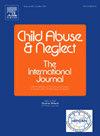探讨对对妇女和儿童实施暴力的男子和父亲的干预措施:范围审查
IF 3.4
2区 心理学
Q1 FAMILY STUDIES
引用次数: 0
摘要
对妇女和儿童的暴力行为——包括身体、性和精神虐待——仍然是一个重大的公共卫生问题,而且经常在家庭中同时发生。虽然针对对妇女和儿童实施暴力的男子和父亲制定了一些干预措施,但许多干预措施没有评估其对儿童的影响。尽管有明确证据表明暴力对儿童的福祉有有害影响,但关于这些干预措施如何影响儿童结局的研究有限。目的本综述旨在评估IPV干预方案对儿童结局的影响。方法利用相关的主题标题和关键词制定了综合搜索策略来识别研究。2024年7月,一名研究馆员在7个数据库中执行了这项研究,得出了4493项研究。筛选文献后,有4篇文章符合本综述的纳入标准。三项研究报告了儿童预后的改善,儿童年龄从0岁到18岁不等。三项研究使用临床医生和家长报告的问卷调查,而第四项研究对儿童和青少年进行了定性访谈。评估了四个项目:关心爸爸:更安全的孩子(n = 38),一起保持安全(n = 8)和建立强大的家庭(n = 3045名父亲),以及一个未命名的项目(n = 138)。结论研究结果表明,IPV干预方案对儿童预后影响的研究明显缺乏。进一步的研究将更好地为政策制定者、研究人员和临床医生提供发展和调整干预计划的内容和结构的信息,以有效地支持父亲和他们的孩子。本文章由计算机程序翻译,如有差异,请以英文原文为准。
Exploring interventions for men and fathers who perpetrate violence against women and children: A scoping review
Background
Violence against women and children —including physical, sexual, and emotional abuse—remains a significant public health issue and frequently co-occurs within families. Although several interventions have been developed for men and fathers who perpetrate violence against woman and children, many do not assess their impact on children. Despite clear evidence of the harmful effects of violence on children's wellbeing, there is limited research examining how these intervention influence child outcomes.
Objective
This scoping review aimed to assess the impact of IPV intervention programs on child outcomes.
Methods
To identify studies, a comprehensive search strategy was developed using relevant subject headings and keywords. It was executed by a research librarian in July 2024 across seven databases and yielded 4493 studies. After screening references, four articles met the inclusion criteria of this review. Three studies reported improved child outcomes, with child ages ranging from 0 to 18 years old. Three studies used clinician- and parent-reported questionnaires, while the fourth conducted qualitative interviews with children and youth. Four programs were evaluated: Caring Dads: Safer Children (n = 38), Keeping Safe Together (n = 8), and Building Strong Families (n = 3045 fathers), and one unnamed program (n = 138).
Conclusion
The findings highlight a significant lack of research on the impact of IPV intervention programs on child outcomes. Further research will better inform policy makers, researchers, and clinicians on developing and adjusting the content and structure of intervention programs to effectively support both fathers and their children.
求助全文
通过发布文献求助,成功后即可免费获取论文全文。
去求助
来源期刊

Child Abuse & Neglect
Multiple-
CiteScore
7.40
自引率
10.40%
发文量
397
期刊介绍:
Official Publication of the International Society for Prevention of Child Abuse and Neglect. Child Abuse & Neglect The International Journal, provides an international, multidisciplinary forum on all aspects of child abuse and neglect, with special emphasis on prevention and treatment; the scope extends further to all those aspects of life which either favor or hinder child development. While contributions will primarily be from the fields of psychology, psychiatry, social work, medicine, nursing, law enforcement, legislature, education, and anthropology, the Journal encourages the concerned lay individual and child-oriented advocate organizations to contribute.
 求助内容:
求助内容: 应助结果提醒方式:
应助结果提醒方式:


